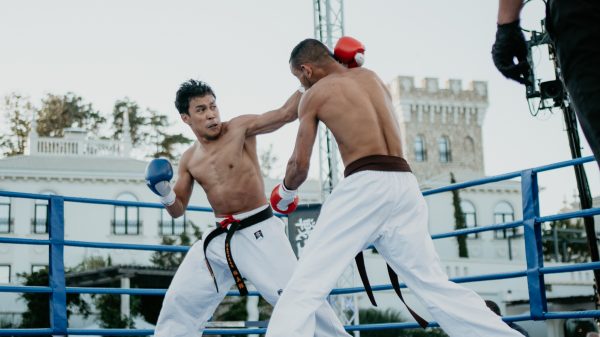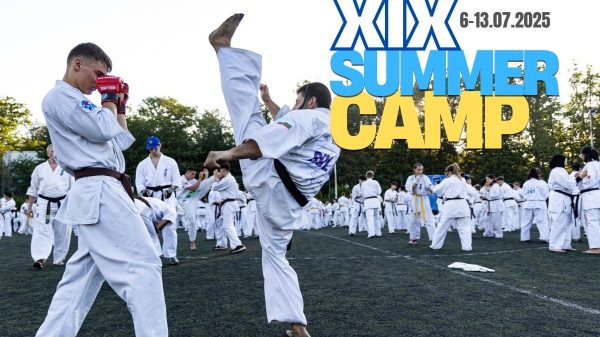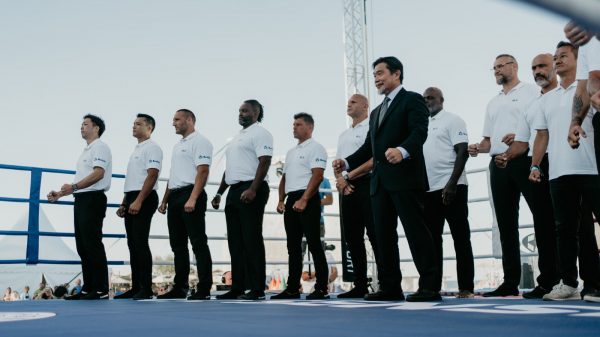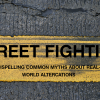The interview with Kacho Hatsuo Royama on the history and perspectives of sport karate

Question: Could you, please, tell us how did develop the sport karate?
Answer: Historically Karate is a martial art which was born on the Okinawa island. Earlier the Kingdom of Ryukyu located on the island. It was an independent state which had its national peculiarities. At the end of the 19th century it was included in Japan as one of its prefectures. At the beginning of the 20th century master Funakoshi Gichin arrived from Okinawa to Honshu, the main island of Japan, where he began to popularize and teach karate. Later such masters as sensei Mabuni, sensei Motobu, sensei Miyagi Chojun and sensei Toyama also arrived from Okinawa to the main island with the purpose to teach karate.
After the end of the World War II karate has begun to develop very actively and has taken permanently the 3rd position in the Japanese martial arts world after Judo and Kendo. Initially sensei Funakoshi Gichin taught karate basing on kata only, while kumite – sparring was no used. When karate began to develop actively especially in universities many students wanted to prove in practice their strength in what they have studied all the time. They wanted to take part in competitions to prove their strength during kumite. It is considered that since that time the competitions in karate have been holding.
However because of the lack of experience in conducting competition bouts there was a necessity to experiment with various variants of free bouts. At that time, for example, the bouts in karate were conducted using Kendo protective gear. But with the karate spreading all over Japan the competitions were held according to the sun-dome rules (without actual contact). These rules have received wider spread and became the basis of holding kumite competitions.
But some time later sensei Oyama Masutatsu has appeared who objected the rules. He said, if kicks and punches were not being carried out with actual contact, then it would not be understandable how much they are powerful. From here Kyokushin takes its origin.
After the end of World War II such masters as Oyama Masutatsu and others went abroad where they demonstrated and taught the art of karate. Thanks to them karate became well known and extremely popular abroad. I think that it will not be an overestimation to say that at present the number of people going in for karate is inferior only the number of people going in for football.
Question: Which kinds of sport karate exist? What is the specific of Kyokushin as a kind of sport karate?
Answer: At present three kinds of competitions in karate kumite can be marked out. In the competitions of the first kind the specially designed protective gear is used. The second kind are the competitions according to sun-dome rules (with stopping of strikes. In this kind the bouts are being conducted without actually hitting the partner, i.e. the strikes are being stopped in some centimeters from the partner’s body.
And the third kind is represented with the bouts with full contact.
Thus it can be said that today three variants of competitions in karate kumite exist.
Oyama Masutatsu opposed the sun-dome rules, which have taken the dominated position in the Japanese world of Karate. In competitions on the sun-dome rules the strikes do not really hit the partner’s body, and decision, whether the strike was carried out or not, is entrusted on judges. Saying with other words, in competitions on such rules it is very difficult to determine whether the strike is really powerful because as a result nothing happens with the partner. Sensei Oyama has often said: «It is impossible to understand how the watermelon is sweet if it is not tasted by yourself». Therefore, in order the technique to be proved by a competitor himself it is necessary to carry out the real strikes in kumite. Without delivering a strike it is impossible to know how much is it effective. So, basing on these principles Kyokushin karate, or, how it is often named, full-contact karate, has appeared, and it was decided to hold competitions on these rules.
I remember that before the first competitions in Kyokushin karate many people said that in competitions held on such rules at least several competitors will die. But we have been holding competitions within several decades to the moment and to the date no one person was killed in these competitions. Seemingly it is as paradox but think yourselves. Because the strikes in this kind of karate are delivered with full contact, therefore the competitors have conditioned hands and legs. Moreover, as they know in advance that opponent can deliver a strike to them, the competitors thoroughly train their bodies and after that only take part in competitions. The statistic of holding the competitions on the rules of contact and non-contact karate shows that there are much more traumas in non-contact karate. In sun-dome karate they often wound lips, knock out teeth. The cases of fractures of jaw bones, displacements of cervical vertebras and similar traumas, which I will not specify here, are not rare. In Kyokushin karate everything usually finishes with bruises and insignificant traumas of the knees. One can say with certainty that the injury rate in full-contact karate is considerably less than in non-contact Karate. The doctors who attend the competitions on both kinds of rules confirm this.
Question: How dangerous are the competitions in Kyokushin karate for participants?
Answer: When sensei Oyama declared Kyokushin karate as the kind where the bouts are being conducted with full contact, this called a large indignation in circles of karate. The reason was that earlier the bouts were conducted with stopping the strikes, and at that time many said, that, if competitors will not stop their strikes, many of them will be killed. In 1969 sensei Oyama held the first Kyokushin karate tournament. At that time, as I have already said, many people believed that enormous number of competitors would die. But these competitions were held successfully, and of course their doubts have not been justified. 44 years have passed since that time and during this time no one person was been killed. Besides, there is thoughtfully elaborated system of ensuring the security of competitors in our rules. At present the competitions are being held among women, veterans and children on these rules, and I can say with certainty that at present in the world of karate such competitions are the most secure.
Question: How the security of participants is being ensured?
Answer: As I have already said when the competitions in Kyokushin in full contact begun, the world of traditional Karate refused to accept us. They believed that the competitions in full contact are extremely dangerous. But in reality it was found that in competitions in full contact competitors practically do not receive traumas, because they have both percussive parts and all body well trained. The experience in the technique of attack and defense accumulated within the decades also plays here an important role. And, of course, the rules ensure the security. We have elaborated the rules for adult competitors and rules for competitions among children, the goal of which is to secure the competitor against traumas.
Question: How did form the relations of Kyokushin with other karate organizations, in particular with Japan Karate-do Federation?
Answer: As you know, the Olympic Games were held in Japan in 1964. At this moment there was a karate boom in Japan. Right then the Zenkuren – Japan Karate-do Federation – was established, the goal of which was the integration of all kinds of karate. But who were those who established the Japan Karate-do Federation? Those were people, who practiced the so-called “traditional”, i.e. non-contact, karate. This non-contact karate became the basis of the federation. Of course, Kyoukushin karate has not become a part of this federation. And in fact it could not become a part of it. Because there is a large difference in rules and in general idea of what karate is. In some time we have established the International Karate Organization which has already developed as the independent unit, but unfortunately until today, I think, it would not be the overestimation to say that there were practically no relations between International Karate Organization and Japan Karate-do Federation. I believe that this gap is to be supplied. We have to communicate with all karate federations very actively.
Question: Which international organizations of karate exist today?
Answer: Frankly speaking, practically each karate organization, each branch has its international organization. For example, Japan Karate-do Federation includes such organizations, as Shotokan, Wado-ryu, Shito-ryu, Goju-ryu, and all of them, as a rule, have their own international organizations. If we speak about the well-known organizations, I think everybody knows WKF – World Karate Federation. This federation includes All Japan Karate-do Federation and other federations from the whole world. But this federation practices so-called “traditional” karate only. Saying with other words, only the federations practicing non-contact karate (sun-dome karate), and even not all of them, are integrated in the WKF.
Today the world of karate, roughly speaking, may be divided in two parts: contact karate and non-contact karate. Of course, contact karate is not a part of WKF. But contact karate as well as the non-contact one are represented today by many international organizations. And, unfortunately, we have to recognize that even the largest of the presently existing international organizations represent only the separate segments of the world of karate.
Question: Is there any organization which could represent the interests of karate in the whole?
Answer: Unfortunately at present such an organization does not exist.
Question: How do you see the goals and tasks of KWU?
Answer: After sensei Oyama died Kyokushin has broken into several organizations. Of course, all of us wanted and want Kyokushin again to become united, but until today we were not able to fulfill the task.
At present Kyokushin World Union (KWU) is established. This organization is registered in Switzerland. Its goal is to achieve the including of contact karate into Olympic Games. Now this Union is including only four organization of contact karate, but I am sure, that when we come to the real work connected with including the contact karate in the Olympic movement, not only other Kyokushin organizations, but also other federations of other contact karate styles, will enter in the KWU. Besides, today in connection with the negotiations between KWU and WKF the idea of establishing an umbrella organization which would be capable really represent all the world of karate has taking shape.
Question: Which was the opinion of Oyama Masutatsu toward the idea of including Kyokushin into the program of Olympic Games?
Answer: If you read the books which Oyama Masutatsu had written you would understand how seriously he took the Olympic movement and how he wanted Kyokushin to be a part of the movement. In 1984 in the Palace of Martial Arts the 3rd Kyokushin World Championship was held. At that time Oyama Masutatsu invited several members of the International Olympic Committee. Sensei always wanted Kyokushin to be spread all over the world and of course he wanted very much that Kyokushin become an Olympic sport.
Question: Which strategy of KWU in regard to the contacts with other international organizations of karate must be?
Answer: I believe that KWU has to become a leader of integration of not only Kyokushin karate, but of all full-contact karate as the whole. Along with this KWU has to actively cooperate not only with the organizations of “traditional” karate, but also with all other organizations with the purpose to establish an umbrella organization, which will be able to lead karate into the Olympic movement.
Take, for example, wrestling. Two kinds of wrestling exist in Olympic Games: freestyle and Greco-Roman. Each kind holds the competitions on its own rules. We also can hold competitions in kumite on several versions of the rules and also have common competitions in kata. At present the number of competitors going in for karate is little less than the number of football players, and the number of competitors going in for non-contact karate is practically equal to the number of competitors going in for contact one. Therefore I would be very pleased when both contact and non-contact karate are included into the Olympic movement.
Question: How do you see the perspectives of the development of KWU?
Answer: Even after the death of Oyama Masutatsu the number of people going in for Kyokushin Karate in each country increases every year. Simultaneously the number of organizations which have gone on the way of Kyokushin and became to go in for the contact karate also increases. I think that if even we will not be able to integrate all the organizations in one organization we have to cooperate with each of the existing organizations with the purpose to come to unity of opinion. I think that at present it is very important that KWU would establish its office in all countries. These offices have to cooperate not only with organizations of Kyokushin, but also with other federations going in for contact karate with the purpose that we, united with one idea, could enter into Olympic Games.






































